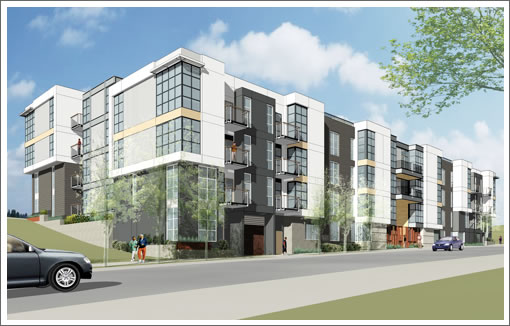
The architectural stylings for the redevelopment of Hunters/Candlestick Point have been revealed. And based on the proposed designs for the “model” blocks, think Mission Bay:
One of the blocks, on the north side of Innes Avenue between Donahue and Friedell streets, will become the site of 63 square-edged, predominantly white-and-gray, for-sale condominiums in a glass-covered, four-story building with covered private parking, a central courtyard and rooftop gathering space, the plans show.
On the other side of Innes Avenue, 25 for-sale townhomes painted with earth-toned colors will line opposite sides of a new alley, which will provide access to nonstreet-fronting ground-floor garages with 36 parking spaces.
Construction on the 88-condos could begin by the end of the year with market-rate price points currenlty expected to range from $400,000 to $700,000.
∙ Plans for Hunters Point Naval Shipyard revealed [Examiner]
∙ JustQuotes: The Redevelopment Of Hunters/Candlestick Point [SocketSite]
what is with bland, squatty buildings, i just don’t get it?!?!?! ok, so the colors shouldn’t offend anybody, but white/gray and glass? yawn!
A decade from now, I think people will look back and say “the 2000’s, cheesy bourgeois architecture and a whole lot of unnecessary greed…”
Ugly as sin, more of the “corner office envy” architectural style.
Having this architecture in the public housing projects should do wonders for changing the style of other new buildings, though.
Terrible location…how is this considered “real sf”?
This area should be considered south city.
Mission Bay is not the style that should be replicated in other parts of the city.
Terrible location…how is this considered “real sf”?
This area should be considered south city.
Unfortunately for many who live in Hunters Point this is “real” San Francisco. The references to “real” San Francisco that is posted so often on SS inherently makes no sense. (I realize many use it in a tongue in cheek way to highlight the ridiculousness of this way of thinking…) Who determines what is “real” versus what is not? By virtue that this development will within the city limits makes it real San Francisco. Unless of course someone decides that HP just doesn’t measure up and should be annexed off into South City as you suggest.
I like them. And they’re being built in an area with a real need, provided the pricing is (relatively) in line with what the community can/will support.
Much of Mission Bay, BTW, is striking. It’s worth noting that there’s a Richard Serra in a public plaza.
[Removed by Editor]
If you’re located within the city limits of San Francisco, then you’re in “real” San Francisco, therefore this reference is redundant. It reminds of of Sarah Palin calling small town southerners “real” Americans, unlike us communists on the left coast.
Jack M — I’m afraid you’re mistaken. The correct definition of “real SF” is the area of the city in which real estate prices continue to rise exponentially and/or hold their value compared to 2008. For exaple, prime Pacific Heights, the very tippy-top of Nob Hill, select parts of Noe Valley and that really neat brick alleyway right at the top of Russian Hill. “Real SF” has been shrinking lately but we’ve been assued it will go back to normal (and expand to include the entire city) anytime soon.
Complaining about the “design” of these units is absurd. For this site, I would time my entry point in terms of the half-life of U-238, not market dynamics.
Oh great. Dead space at ground level… garage doors and garage grates.
arghhhhhhh
If you want to see what this will look like, just go over to Emeryville and check out the area between Hollis and San Pablo between 65th and 67th. As if Mission Bay architecture is good…
BobN,
Yes, that’s a very unfortunate by-product of some condo developments. I was walking through Mission Bay 2 week-ends ago and was struck by the lack of activity from a pedestrian standpoint. This is a pretty uninteresting area by itself in terms of visual entertainment once you go past the BB and a few water views (that you don’t really get as a pedestrian as it’s pretty flat out there). You have a few “boutique” businesses, mostly eateries and that’s about it.
Real SF is San Francisco before a certain date, say the death of Herb Caen, if you are a caenophile. Alternatively, it is those buildings that make an urban person over 50 feel at home. It excludes live-work lofts, Richmond specials, and almost all new buildings south of Market, and anything that might have been built in Atlanta in recent years.
It includes most of northern SF, much of the Richmond, all of West of Twin Peaks, and most of the Sunset. It may or may not include Park Merced, which was the SOMA of its day. People who like Real SF are totally prejudiced.
I recently droved up Mission Street from Chavez, for the first time in a long time. I cannot understand what is so hip and desirable and precious there. Could someone please inform me of what I failed to recognize?
Mission street between Cesar Chavez and say, 23rd? Whoever said it was hip, desirable, or prescious in the first place?
There are a lot of good and inexpensive home cooking style ethnic restaurants on that strip. Otherwise I wouldn’t exactly call that stretch “hip.” There are a few dive-y type bars too.
No, all the way up Mission, Chavez to South Van Ness. I had been told the Mission was “with it” but it appears still to be “without it.”
There have been significant gentrification on the blocks between 23rd and 20th or so. I’d also rate the blocks south of Cesar Chavez, from like Fair to Cortland as having undergone significant changes in the past five or six years. Whether or not they’re noticeable from a car or not, I can’t say.